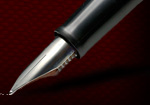Other Work
NASA Releases Images Of Mars Life Evidence;
Space Agency Invites Further Inquiry by Others
By Kathy Sawyer
The Washington Post | Thursday, Aug. 8, 1996, Pg. A03
As NASA scientists released what may be the first images showing evidence of an extraterrestrial life form, President Clinton yesterday hailed the discovery as potentially "one of the most stunning insights into our universe that science has ever uncovered."
"I am determined," he said, "that the American space program will put its full intellectual power and technological prowess behind the search for further evidence of life on Mars."
Yesterday with the world still reacting to the initial headlines about possible signs of life on a bit of meteorite from Mars, the focus shifted to the portentous question that comes next: How can the science community validate one of the most extraordinary claims in human history?
NASA Administrator Daniel S. Goldin, acknowledging that the find is controversial, told a packed news conference at agency headquarters that he welcomes independent research by all qualified comers worldwide. He said samples of the meteorite, which is stored in a sanitized sanctum at Johnson Space Center in Houston, will be made available to the science community.
"We want these results investigated, and we're prepared to make samples of the rock available to meritorious proposals that go through the scientific process. We want to take the time to do this. And if it takes a year or two years, so be it."
The comments followed revelations that a meteorite found in Antarctica in 1984 has yielded promising evidence that primitive microscopic life existed on Mars 3.6 billion years ago. The findings -- after passing through what some scientists described as an unusually rigorous peer review process -- are scheduled to be published in the Aug. 16 issue of the journal Science. The news leaked early and was widely reported Tuesday.
At yesterday's news conference, the team led by David S. McKay and Everett K. Gibson Jr. of the space center presented eerie images of the microscopic evidence they found inside the fissures of the 4 1/2-pound meteorite. Photographers jostled for position around a fist-sized sample of the grayish rock, nested in black velvet inside a glass case.


